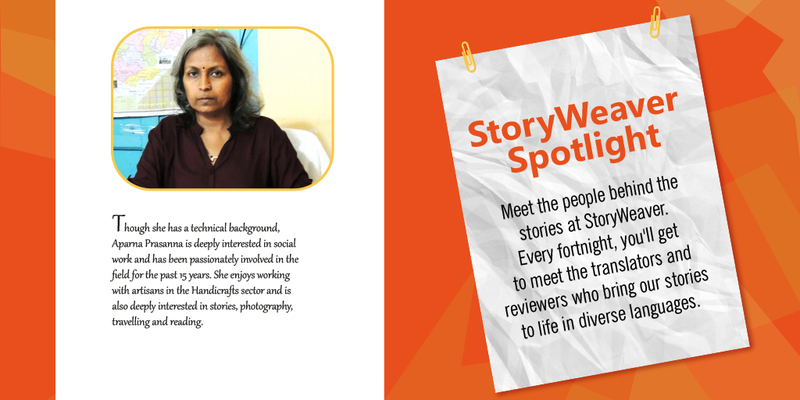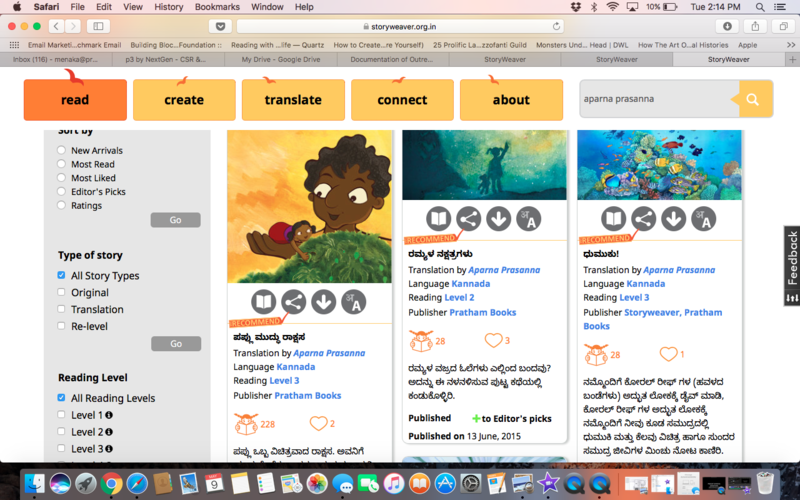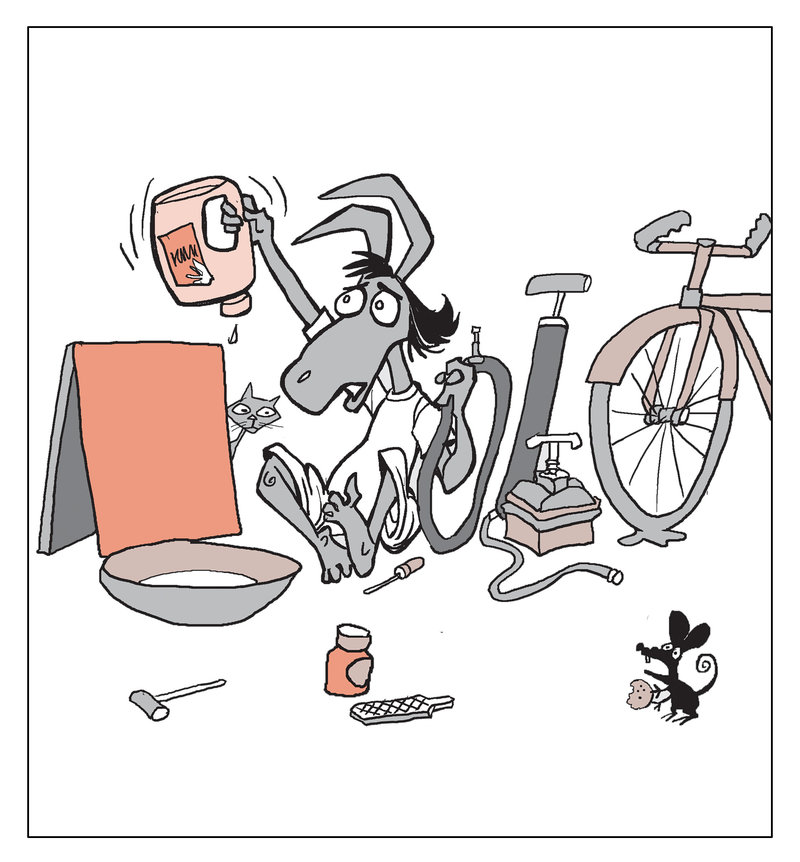StoryWeaver Spotlight: Aparna Prasanna
Posted by Remya Padmadas on May 09, 2017
Q: What do you usually read? Which language do you prefer to read
Fiction, non-fiction, history, mythology. I read anything I can lay my hands on. I prefer to read in Kannada and English.
Q: Do you have a favourite book / author and why is it a favourite?
Yes, 'Mankutimmana Kagga' and 'Kaanoorina Heggadati' in Kannada are my favourite books.
Q: You have contributed for us immensely. How has the StoryWeaver journey been?
It has been a wonderful journey, I have enjoyed every bit of it.
Q: Could you share with us a story or anecdote from the translations / reviews? Or one big thing that you take away from this experience?
I have loved experiencing my childhood again with children surrounding me while I read them these stories.
Q: How does it feel when your story gets published online?
Oh! It brings a smile on my face.
Q: You have translated / reviewed a handful of stories for us. Which one has been your favourite and why?
There are two books I am particularly fond of: 'Jadav and the Tree Place' and The Wall Book.'Jadav and the Tree Place' is a very positive story showing how we can create wonders and that efforts do not go wasted. The Wall Book was full of information on human race and its civilisations, which I loved.
Q: What is your key driver in taking this up?
I do feel strongly about my language. And I enjoy translating stories for children so that they can read in their mother tongue.
Q: How else do you think we can join hands in taking bigger steps for children’s literature?
I think introducing story telling sessions, where the kids can narrate stories would be a good step.

Q: How has the overall experience with StoryWeaver been?
ಅತ್ಯಂತ ತೃಪ್ತಿದಾಯಕವಾಗಿತ್ತು. ಅದ್ಭುತವಾದ ಕಲಿಕಾ ಅನುಭವವಾಗಿತ್ತು
Immensely satisfying and a wonderful learning experience.
Q: You seem to be having fun with the translations and reviews…could you share your 'secret recipe' for this with us?
I just love what am doing!
Be the first to comment.The creator of Gardhab Das, Target Magazine's iconic cartoon character, on creating Gadbad Das for Pratham Books!
Posted by Amrita Bose on April 09, 2019If you grew up during the 80s and the 90s, you could not not have pored over copies of popular children’s (in today’s time it would have targeted the Young Adult category) magazine Target, published by the India Today group. A constant companion during long train journeys, sultry afternoons during summer vacations, copies of Target magazine were zealously guarded from annoying friends with borrowing-but-not-returning habits. Along with a slew of reader contributions, in-house features (anybody remembers that fantastic page dedicated to pen friends?) Target ran a bunch of popular comic strips including Detective Moochhwala by Ajit Ninan, Granny’s Gupshup by Praloy Chakravorty, It Happened in History by Renuka Narayanan. But perhaps the most memorable character remains Gardhab Das, a kurta-pajama wearing, harmonium wielding donkey, who was also an unemployed music teacher.

Co-created by cartoonist brothers Neelab and Jayanto Banerjee, Gardhab's favourite weapon for “mass destruction" was his singing talent or the lack of it. His singing mostly landed him in trouble, but sometimes it also got him out of sticky situations.
And bringing back the charm of Gardhab Das and the nostalgia associated with him is Jayanto with his newest creation for Pratham Books: Gadbad Das, son of Gardhabh, a millennial of sorts, but unfortunately for him, musical talent is still not in his genes. Gadbad lives in small town India. Like his pa, Gadbad is a terrible singer too. Everybody knows this, except him! Gadbad does various odd jobs to survive and solves his problems musically mostly. Like in his debut book — No Water for you, where Gadbad has to fix a puncture in his cycle shop, but he has run out of water. Off goes Gadbad to find some water, but it’s not as easy as you’d think.
Gadbad’s creator Jayanto, who has, post Target, done stints at India Today, Times of India, and Hindustan Times as a cartoonist, tells us why he decided to resurrect Gardhab Das into our lives again with his mini-me: Gadbad, reminisces about Target days and creating an iconic cartoon character.
What was the original inspiration for the Gardabh Das comic strip that ran in Target from 1980s to early 90s?
To do that I will have to go back to that era. This was the late 1980s and the editor of Target was Rosalind Wilson, a British lady. She wanted an Indian cartoon strip to be created as a double spread in the magazine and Neelabh and I met with her to discuss the possibility of creating a comic strip once in three months. Her brief to us was very clear, “It should be about your life [ we were from Lucknow], the comic strip needs to have a small town feel to it. We thought about it and decided that unlike every other comic strip that had superheroes, our hero basically would be a loser. He would be terrible at singing and unemployed and that kind of gave us that a fertile space to create really funny situations that protagonist Gardhab Das keeps getting into.
What was the appeal of Gardhab Das during his time?
Gardhab had to be an everyday character, and relatable to kids, their parents and grown ups as well. What was to be a three-monthly comic strip (featured as a double spread) soon became a monthly affair thanks to its immense popularity. In fact Gardhab became so popular that the comic strip became part of Target’s popular yearly diary, made it to annual issues and even got its own digest. There was a point in time when Gardhab was going to be killed off because its illustrator Neelab (Jayanto claims his brother was much better at creating Gardhab than him) had decided to move on, but the then editor Vijaya Ghosh insisted that Jayanto continue with the comic strip and it had another successful run for the next few years until the magazine shuttered.
What inspired you to create Garbad Das for Pratham Books? How is Gadbad similar or different from the legendary Gardabh Das?
Initially while discussing with the Pratham Books editorial team we wondered whether we should bring back the original Gardabh Das for the book. But we realised that Gardabh belonged to another era and we wanted to contemporise the character even though father and son have the same talents. Hence we decided to introduce Gadbad Das, son of Gardabh Das, a character who was born after the year 2000. Even though Gadbad might be contemporary, the look and feel of the character and the setting are more small town than metros. A hand pump, a very rare site in big cities is still prevalent in small town India. But water and water shortage is a common problem that plagues the entire country.
Jayanto hopes that Gadbad Das can become a series and become as popular as his illustrious father. Characters such as RK Laxman’s Common Man and the Amul Girl have grown on us, and are still going strong, so why not Gadbad Das, says Jayanto.
comments (7)
The Zombie Wizard-Cat of Oz (Part 1 of 2)
Posted by Remya Padmadas on September 22, 2017Vinayak Varma, writes and draws things. He has written, guest edited and art directed STEM picture books for Pratham Books. Visit him at www.instagram.com/mixtape.in
Give nine people the exact same brief, and there’s a good chance that you’ll end up with nine different kinds of output. I’ve always been curious to know what happens on that journey between idea and execution, and what makes similar stories live out such different lives in the minds of different artists and writers. This is perhaps the only thing that motivates me to collaborate with others, speaking as a cranky hermit type who prefers working alone.
I write and illustrate for a living (a large part of which has lately been in aid of PB StoryWeaver). Every new project I take on is invariably a triathlon event that begins with a plunge into the Bottomless Pool of Procrastination, followed by a deathly plod across the Minefield of Migraines and a bicycle race through the No-Man’s-Land of Forgotten Deadlines. Somewhere along this crazy path, the odd conceptual tangents that inform the best parts of my work tend to sneak up on me like little ninjas. I'm usually too annoyed or preoccupied while I’m working to make note of precisely how any of it happened, and once the moment has passed and the job is done -- provided that job has any depth, truth or beauty to it -- it's easy enough to shrug and pretend like I'd been hit by some Joycean haiku moment.
But mastery of one’s art comes from understanding the mechanics of these creative accidents. If you can unpack it, you can duplicate it. However, the trouble with writing stories or making art is that they require you to exist in an isolated, meditative bubble where you're engaging deeply with the problem at hand, whereas the route to this bubble is through much distraction and muddled thinking. In order to parse the finer workings of this process, you need to be able to slip outside of your bubble at will (while maintaining an accessible distance), catch yourself in the act of being creative, and then be detached enough to pause and document what's happening. It’s a dilemma akin to that of Schrodinger’s cat -- the creative moment exists in a sort of delicate half-alive, half-dead state, where the very act of observing it risks killing it.
Of course, there are other, loftier parts to publishing, from where one can gain an interesting new vantage of some these abstract areas of book-making: hello and welcome to the Highlands, where clowders of editors scour the hillsides for errant adverbs like goats looking for tasty trash. These are cold, dry places where many authors and illustrators don’t dare venture for fear of losing their precious senses of self. Well, I do go there every so often, because I’m foolhardy like that. Here’s what I discovered up there: nothing returns your inner moggie to its quantum state like stage-managing the creation of picture books (as opposed to being one of the actors out in front). Editing and art directing let you view and gently influence the many moving parts of a project, watching creativity in action, without the blinding pressure of being the primary authorial voice. You get to observe the zombie cat but, also, you ARE the zombie cat. I recommend this exercise to all writers and illustrators at least once in their careers: not only does it let you see how other people make things, thereby enriching your own work, but it also acquaints you with the terrible power and omnipotence that commissioning editors have to live with daily. This can build empathy, if nothing else.
I got my most recent taste of this awesome power last year when I was hired to commission a set of nine STEM picture books for Pratham Books' StoryWeaver. I planned, ideated, edited and art directed four of these, which were on science. I got to art direct another four, from editor Bijal Vachharajani’s set of environment-themed stories. And I wrote and illustrated the ninth, themed on emotional intelligence, which meant that I too got to make, even as I guided and observed others in the act of making. In sum, I got to pull back the curtain and see all the wheels turn at once, to catch the decaying particle as it sped towards the poison vial, to expose the regular dude masquerading as… as…. a wizard… no, a dead cat… no, a living cat… no, a mountain goat... Look, the point is: this scarecrow has a fresh, insight-filled brain now. Chew on that, zombies.
I’m going to try and share some of that insight (or at least a bit more about the merits to following my particular path to such insight) in part 2 of this post, next week. Meanwhile, let’s look at some of the books that I just mentioned:
The Science Books
For the set of science books that I had to both edit and art direct, I was asked to come up with a few interesting themes and story ideas, and, once they'd been approved in-house, to farm them out to freelance writers and illustrators who were best suited to each idea. Four stories were then shortlisted from the seven or eight ideas that I suggested to my commissioning editors at Pratham Books (yes, even commissioning editors like me have commissioning editors, who in turn have other, bigger, older commissioning editors, who answer to still larger, greyer commissioning editors, etcetera, etcetera, all the way down, like the proverbial Jenga-stack of cosmic turtles).
I'm going to show you exactly how rudimentary these four early ideas were, so that you can gasp and grow silent with awe when you see what they ultimately became in the hands of my talented gang of writers and illustrators. Hold onto your seats.
--
"Dear Commissioning Space-Turtle #X,
Here are some ideas:
1. A kid has a cold. S/he then gives it to everyone else in his/her class via sneezes and things. Because epidemiology, boss.
2. An old lady heads out with a walking stick and her grandkid in tow. She uses her stick in various fun ways during the walk, pushing, pulling, propping up, etc., thereby demonstrating how simple machines work. Because physics and stuff, boss.
3. On birds devolving into dinosaurs, a la the chickenosaurus conjecture. Cluck, roar, repeat. Because why the hell not.
4. Crocodiles? Reptiles? Rom Whitaker? Because conservation biology, kids.
+ a few more that probably aren't worth going into given space(!)-constraints in this fake-email-within-an-already-interminable-blog-post.
Sincerely,
Commissioning Space-Turtle #Y"
--
As you can see, the whole scheme began with a pith of one-liners that bore a 50-50 potential to go either way: to turn into something halfway-decent, or utter trash. What emerged at the end of their gritty evolution into book-hood, though, would you believe it, were these beauties:
Sniffles: in which Sunando C used bold, striking illustrations and crisp storytelling to turn a sad and lonely germ of an idea into a full-blown epidemic of football and high-fives and cool hats and general cuteness (plus, in a more literal sense, a sustained spray of sneezes, sickness and snot, so keep your antiseptic soaps handy). And those colours! Those characters! Those compositions! Those Norman-Jewison-esque split-screens! Killer stuff!

Ammachi's Amazing Machines: It’s like that original walking stick idea has been sliced up and Frankensteined by a mad surgical team consisting of Rube Goldberg, Professor Branestawm, Mr. Bean and Sathyan Anthikkad. Here’s what I’m interested in knowing: is there anything Rajiv Eipe can't do? Seriously, is there? I've asked everyone, and no one seems to have the answer. I'm willing to pay good money for this information. (Also: simple-machine barfi, FTW.)

Kaakasaurus: Terrifying, scaly, toothy, large, angry, feathery, strange, destructive, and hungry are all adjectives that one could apply to Shalini Srinivasan and Prabha Mallya (but I’m told it would be impolite to do so). Their picture book, however, is all of those words, but also happy, shiny, funny, smart, and crunchy like a hot bajji. There’s a Jurassic Park spin-off script in there somewhere, by the way, and Spielberg (or Robot Shankar) would be well advised to quickly option it while this crow is still a crow.

Ghum-Ghum Gharial’s Glorious Adventure: Now here is a story you can lose yourself in; a deeply affecting bildungsroman about the meaning of family, about love, loss and self-actualisation. The story and art by Aparna Kapur and Roshan, respectively, are so rich with truth, heart and lyricism. It ticks all the right literary / artistic boxes, I tell you. What makes this book truly stand apart, though, is that it’s also filled with an incredible polyphony of nose-wart-blasted fart-noises. Beat that, Odysseus!

You should go read these books, and share them with your kids, if you haven’t already. Did I mention that they’re all free? No? Well, they are too. The links are in the book titles (above). This is your cue to leave this page. GO!
Next week, in part 2 of this post: Four more picture books, more monstrously mixed metaphors (and other atrocious alliterations), an angry, angry, angry kid, and the Final Fate of Quantum Limbo Cat!
Be the first to comment.